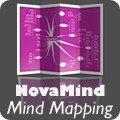Mind mapping
Mind mapping is a concept developed by psychologist Tony Buzan and has developed into a popular tool for helping us think ‘laterally’ – it’s essentially a type of brainstorming.
If you prefer, you can use the traditional brain storming approach to create your wish-list by jotting down as many random thoughts as possible, thinking up wild, zany, off-the-wall ideas and connections.
The limitations of traditional brainstorming are in its structure.
By default, the output from brainstorming is a set of top-to-bottom and left-to-right lists on a page or over several pages. This automatically creates a bias in your mind that the item on the top of the list is the most important, when this is not necessarily the case.
The brainstormed lists also don’t reflect the inevitable and complex connections that exist between topics. Without a link, the relative importance of this item on the list may be lost.
The concept of Mind Mapping [also called concept mapping] is based on a central idea written in the center of a page, then related ideas are added on branches that radiate from this central idea. Because of this structure, it requires all ideas to be connected to the centre and allows connection to one another, providing opportunity for convergent thinking, fitting ideas together, as well as thinking up new ideas.
And by focussing on key ideas written down in your own words, and then looking for branches and connections between the ideas, you are plotting your thoughts and ideas in a way that will help you understand and remember the information. Keep the following points in mind when creating a Mind Map:
- Don’t think too much about structure as you’re preparing the map – just let it flow as you work through the process
- Work through it quickly to keep up the flow of ideas
- Keep the points brief – you can expand them later
- When you get a new idea, add a new branch line
- Use sketches, images and pictures (if you can) – it makes it easier to remember and more personal, but make sure it doesn’t slow down the brainstorming flow. ClipArt is great for this!
- Once you’ve got it all down, stand back and take a look. What’s missing? What are the recurring ideas? Where are the connections?
- Continue! It’s a work in progress.
A Concept Map is a useful tool not only for goal setting [refer to the section on 'Mind Mapping for goal setting'] but for planning of any home or work project. If you haven’t got the knack of drawing the map yourself (don’t worry, a bit of practice and you’ll get there), there are a couple of software packages you can obtain.
Sticky Note Mapping
A variation to the traditional mindmap and the software versions, is something called “sticky note mapping”.
As its name suggests, it involves the use of sticky notes – lots of them.
Sticky note mapping is a brainstorming technique based on the mind map principle, that allows you to ‘storm and sort’ your ideas without having to re-work your mind map or edit your mindmap software.
To do a sticky note map, you’ll need a large section of blank wall or something like a whiteboard, and lots of sticky notes. Using a variety of sticky note colours and sizes, simply jot down all your thoughts on the sticky notes – with each new thought or concept on a new sticky note.
As you write down your thoughts on the sticky notes, stick them up on the wall or whiteboard – you can group them into similar themes as you stick them up, but the best thing about using sticky notes for this map is that you can move them around as your thoughts develop.
Like mindmaps, once you’ve jotted down all your thoughts and stuck them on the wall, look for branches and connections between the ideas. What’s missing? What are the recurring ideas? Where are the connections?
When you’ve sorted the sticky notes into a map that makes the most sense of your thoughts, you can either take a photo of it as your record, or draw it as a real mind map (or use the mindmap software available).
Sticky note mapping will give the same outcome as mindmapping, but is a good technique if your’re really not sure where to start with your mind map.
|
From the ‘inventor’ of the Mind Map – Tony Buzan - this book shows you not only how to do a Mind Map, but how to apply it to different tasks – study, creativity, projects, etc. Using practical examples and a step-by-step approach, you’ll be an expert mind mapper in no time at all. Harness the power of mind mapping to improve your mind power! |
|
Brainstorm is your personal map to better understanding creative thinking and the brainstorming process. This book will teach you the basics of how to produce many ideas, evaluate each of them, and pick the best one. This book also features in-depth interviews and profiles of a handful of well known people whose brainstorming skills have led them to incredible success. |



